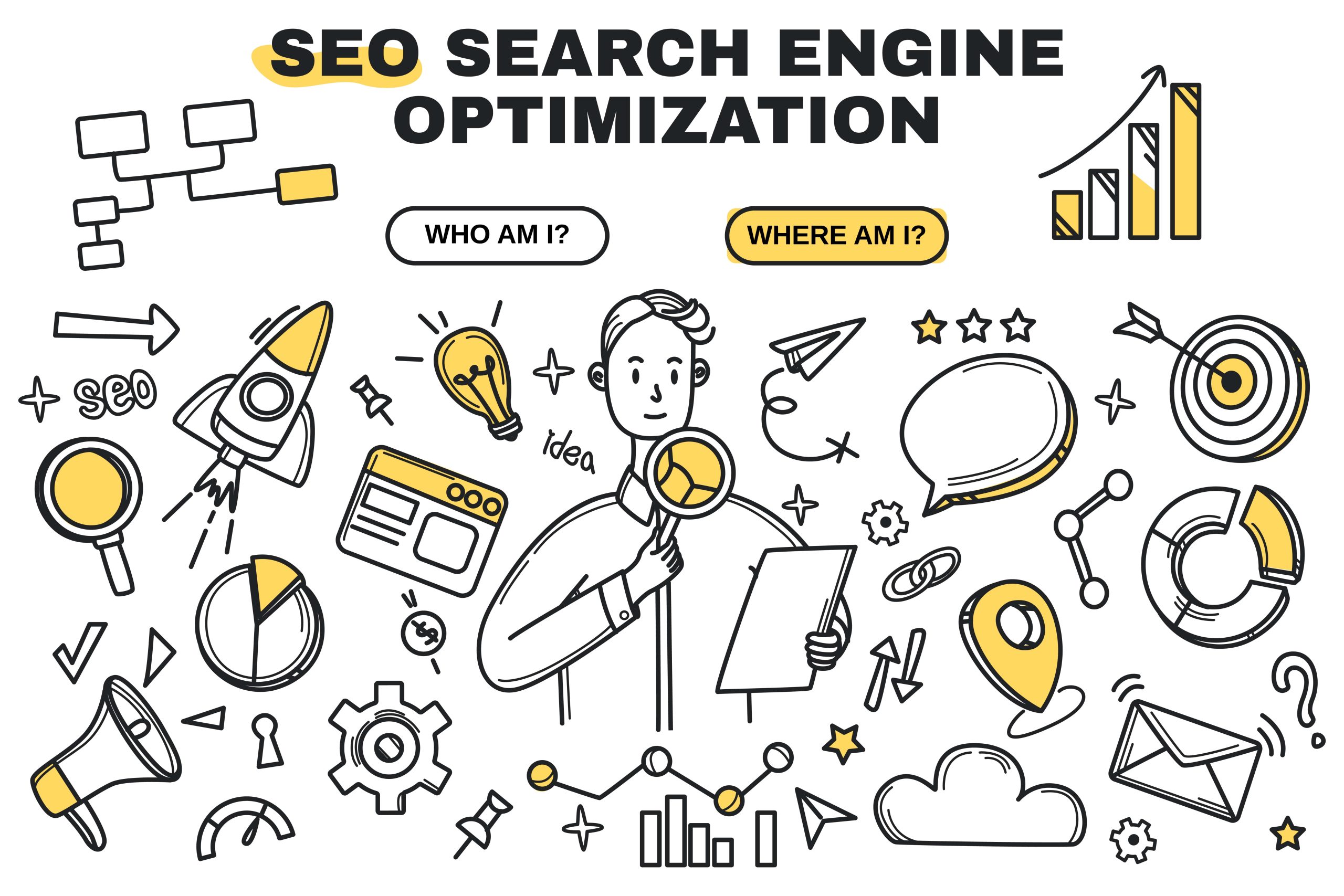When we discuss enhancing websites for search engines like Google, the term “Search Engine Optimization” or SEO frequently comes up. But there’s a specific, super-important part of SEO that many people don’t know about, and it’s called “Technical SEO.” If you imagine SEO as a grand building, Technical SEO is like its strong foundation, ensuring everything stands tall and steady. But what does Technical SEO do? It’s all about the behind-the-scenes work.
It ensures the website is built and structured in a way that makes it easy for search engines to come in, look around, understand what’s on offer, and then list it correctly in search results. This includes things like making sure the website loads quickly, works well on mobile phones and is secure for users. All of these factors don’t just help with search engines; they also make a website better for its visitors. So, while Technical SEO might sound techy and complicated, it’s essential for both search engines and real people trying to use a site.
What Is Technical SEO?

Technical SEO refers to the process of optimizing the structure and infrastructure of a website to ensure that search engines can efficiently crawl, index, and render its content. This involves optimizing elements such as site speed, mobile responsiveness, sitemaps, internal linking, and security protocols, among others. Unlike other aspects of SEO that focus on content and backlink strategies, Technical SEO emphasizes the web site’s foundational and technical aspects to enhance both user and search engine experiences.
Why is Technical SEO Important?

Imagine building a state-of-the-art facility, but the roads leading to it are riddled with obstacles, or even worse, there’s no clear sign indicating its entrance. This is analogous to having great content without proper Technical SEO. Your content, regardless of its quality, remains obscure without the foundation laid by Technical SEO. Moreover, as algorithms evolve, search engines are becoming more user-centric. They prioritize sites that load faster, are secure, and offer an optimal user experience, especially on mobile devices.
1. Foundation for Other SEO Efforts
At its core, Technical SEO provides a solid base upon which other SEO strategies are built. Just like constructing a house requires a stable foundation, effective keyword research, content optimization, and link-building campaigns necessitate a technically sound website to truly flourish and gain traction.
2. Improved Crawlability & Indexing
Technical SEO strategies, such as optimizing XML sitemaps and Robots.txt, ensure that search engine bots can efficiently crawl and index a website. This translates into search engines understanding and categorizing a site’s content better, leading to more accurate search results listings.
3. Enhanced User Experience
From mobile optimization to site speed improvements, Technical SEO focuses on making a website user-friendly. A site that loads quickly is easy to navigate, and displays correctly across devices invariably retains users longer and reduces bounce rates.
4. Elimination of Duplicate Content
Canonical tags, a tool in the Technical SEO arsenal, address duplicate content issues, pointing search engines to the original content source. This ensures a website’s pages don’t compete against each other in rankings, concentrating SEO value.
5. Boosted Page Speed
A faster-loading site isn’t just a user preference; it’s an SEO must. With Technical SEO, optimizations like compressing images, leveraging browser caching, and minifying code can dramatically speed up page load times, directly impacting rankings and user satisfaction.
6. Secure and Accessible Websites
Through HTTPS protocols and structured data markup, Technical SEO helps in making a site more secure for users and easily interpretable for search engines, fostering trust and better understanding.
7. Optimized Mobile Experience
With mobile searches consistently outpacing desktop, Technical SEO’s emphasis on mobile optimization ensures sites are responsive and tailored for mobile users, accommodating the changing dynamics of user search behavior.
8. Reduced 404 Errors
Regularly auditing and rectifying broken links minimizes 404 errors. By addressing these issues, Technical SEO ensures that users have a seamless browsing experience and that search engines don’t encounter dead-ends, enhancing site credibility.
9. Clear URL Structure
A descriptive and organized URL structure gives insights into a website’s content hierarchy. Through Technical SEO, URLs can be optimized to be more intuitive and meaningful, guiding both users and search engines.
10. Maximized Organic Traffic
All the above points coalesce to this major benefit – a surge in organic traffic. With a technically optimized site, search engines rank pages higher, leading to increased visibility and attracting more organic users to the website.
Key Factors of Technical SEO

When discussing SEO, it’s crucial to recognize the silent gears working in the background, driving a site’s performance. These gears, intrinsic to Technical SEO, play a vital role in how well search engines and users interact with your site.
1. Crawlability
Imagine the vast web as an enormous library. Now, how would a librarian (in this case, a search engine) locate a particular book (your website) if it’s not even on the shelves? Crawlability ensures that search engines can find and access your web pages without any hiccups. Tools for this include robots.txt files that guide search engines on what to access and what to skip, and sitemaps that provide a roadmap of your site. Essentially, it’s about making sure there are no closed doors or detours preventing easy access.
2. Indexability
Imagine the internet as a big library, and every website is a book. ‘Indexability’ is like deciding which books should be easily found on the main shelves. When search engines like Google look at a website, they need to decide which pages are important enough to show people when they search. Not every page on a website is useful or needs to be shown. Indexability helps make sure that only the best parts of a website are put out there for people to see. It’s like putting the most popular books front and center in our library so readers can find them quickly. This way, when someone searches for something on Google, they see results that are most useful to them, and websites make sure only their best pages are on display.
3. Site Structure & Internal Linking
Think of this as the table of contents and index in our library book analogy. A coherent site structure helps search engines gauge the weight and relevance of content. Robust internal linking, on the other hand, spreads the importance or “link juice” across pages, emphasizing the pivotal parts of your site and aiding in easier navigation.
4. Site Speed
Today’s digital age is all about instant gratification. A sluggish website is like a book with pages glued together; no one has the patience for it. Not only do faster-loading websites rank higher on search engines, but they also offer users a smoother, frustration-free experience, increasing the likelihood of them sticking around.
5. Mobile Optimization
The digital shift to mobile is here, and it’s transformative. With most users now tapping away on their smartphones to browse, shop, or seek information, mobile-optimized websites have moved from the ‘nice-to-have’ category to ‘absolutely essential’. This is not just about shrinking a website to fit a smaller screen. True mobile optimization ensures an intuitive user experience, rapid loading times, and fluid navigation. Search engines recognize this paradigm shift. Google, for instance, has implemented mobile-first indexing, meaning it predominantly uses the mobile version of the content for ranking and indexing. Websites that aren’t optimized for mobile not only frustrate users but risk falling in search rankings. In today’s age, to stay relevant and accessible, embracing mobile optimization is paramount.
6. HTTPS and Security
In the vast expanse of the internet, safety is paramount. Both savvy users and search engines are on the lookout for websites that ensure data protection. Enter HTTPS – the secure version of HTTP. This protocol safeguards the data transferred between the user’s browser and the website, acting as a shield against malicious activities. Websites with HTTPS convey a sense of trust, showing visitors their information is safe. And it’s not just about user trust. Search engines, particularly Google, give ranking advantages to secure sites, making HTTPS migration not just about security but also about visibility. In a nutshell, integrating HTTPS isn’t merely a technical tweak; it’s a commitment to user safety and website credibility.
7. Duplicate Content
The internet thrives on originality. When similar or identical content appears in multiple places on the web, it creates what we call ‘duplicate content’. This poses a dilemma for search engines: which version of the content should they display in the search results? To tackle this, search engines might skip showing duplicate content altogether, which can affect website visibility. Beyond the visibility concerns, duplicate content can also dilute link equity and compromise the site’s authority. Addressing this issue involves using canonical tags, which essentially tell search engines which version of the content is “original” or “preferred.” In essence, steering clear of duplicate content and properly managing it when it does arise ensures a website’s content gets the recognition and visibility it rightfully deserves.
8. XML Sitemaps
Think of an XML sitemap as the table of contents for your website, specifically designed for search engines. While users navigate through eye-catching designs and intuitive menus, search engines rely on XML sitemaps to swiftly identify and access key pages. Presented in an XML format, this sitemap lists URLs for a site and additional metadata about each URL (like when it was last updated). By submitting an XML sitemap to search engines, webmasters can aid and expedite the indexing process, ensuring all vital pages are considered and none are overlooked.
9. Robots.txt
The robots.txt file is like the gatekeeper of your website, guiding search engine bots on where they can and cannot go. Located in the website’s root directory, this file provides directives to web crawling and scraping bots about which directories or files they should skip. It’s a powerful tool, especially for large websites or those with specific pages that shouldn’t be indexed, like admin areas or private directories. However, it’s crucial to handle it with care, as incorrect configurations can accidentally block essential content from search engines.
10. Core Web Vitals
Google’s initiative to make the web more user-friendly, Core Web Vitals, focuses on three main pillars of user experience: loading, interactivity, and visual stability. First, there’s the “Largest Contentful Paint (LCP),” which measures how quickly the main content of a page loads — a critical aspect as users don’t like waiting. Then, there’s the “First Input Delay (FID)” that gauges interactivity, especially the time taken for a page to become interactive after a user action. Finally, “Cumulative Layout Shift (CLS)” assesses visual stability, ensuring elements on a page don’t unexpectedly move around. In the world of SEO, these metrics aren’t just numbers; they impact real-world user experience and subsequently search rankings.
11. Hreflang Tags
As the internet becomes more global, content needs to be more localized. Hreflang tags are the solution to this challenge. These HTML tags indicate to search engines the language and regional targeting of a page, ensuring the right content gets in front of the right audience. Suppose you have content in English for the US and the same content in Spanish for Spain. Hreflang tags would help search engines deliver the appropriate version to searchers in these regions. It’s an indispensable tool for websites with multi-language or multi-regional content, ensuring users get the most relevant content based on their language and location.
12. Redirects
Imagine walking to your favorite shop and finding out it’s moved to a different location, but without any sign pointing to where it’s relocated. Frustrating, right? In the digital landscape, redirects play that pivotal role. When a web page’s URL changes, a redirect ensures that users and search engines are smoothly taken to the new location, retaining the traffic and SEO value. The two most common types are 301 and 302. A 301 redirect tells search engines (and users) that a page has permanently moved to a new address, passing most of the original page’s SEO value. In contrast, a 302 signals a temporary move. Handling redirects with precision is vital to maintaining search ranking and offering a seamless user experience.
13. Broken Links
Navigating a website only to encounter a “404 Not Found” error can be a frustrating experience for users. Broken links, essentially pathways that lead nowhere, can erode trust and degrade the overall user experience. From an SEO perspective, search engines see a website riddled with broken links as potentially neglected or outdated, which can negatively impact its rankings. It’s essential for webmasters to periodically audit their websites using tools or manual checks to identify and rectify these links, ensuring a seamless navigation experience and maintaining the site’s credibility.
14. URL Structure
A website’s URL isn’t just an address; it’s a signal. A well-structured URL can provide both users and search engines with context about the content of a page even before it’s visited. For users, a descriptive URL like “example.com/womens-shoes/sneakers” is intuitively more informative than “example.com/product12345”. For search engines, a clean and organized URL structure can offer insights into the hierarchy and categorization of content. It’s akin to a well-labeled filing system, making it easier to understand and index the website’s content effectively.
15. Canonical Tags
In the vast digital landscape, instances where the same content appears in multiple locations are common. This can lead to confusion for search engines, which might struggle to determine which version to rank. Canonical tags come to the rescue here. By adding a canonical tag, webmasters can signal to search engines which version of the content is the authoritative one. This ensures that any SEO value (like backlinks) attributed to the duplicate pages consolidates towards the canonical version, streamlining indexing and preventing dilution of ranking power.
16. Page Depth
Imagine visiting a library where the most valuable books are stashed away in the remotest corners. A deep page depth on a website has a similar effect. If crucial content is buried too many clicks away from the homepage, users might abandon their search, and search engines might deem those pages less important. Maintaining a shallow site structure, where vital pages are accessible within 3-4 clicks from the homepage, not only improves user engagement but also ensures that search engines can easily discover and assign relevance to those pages.
































































